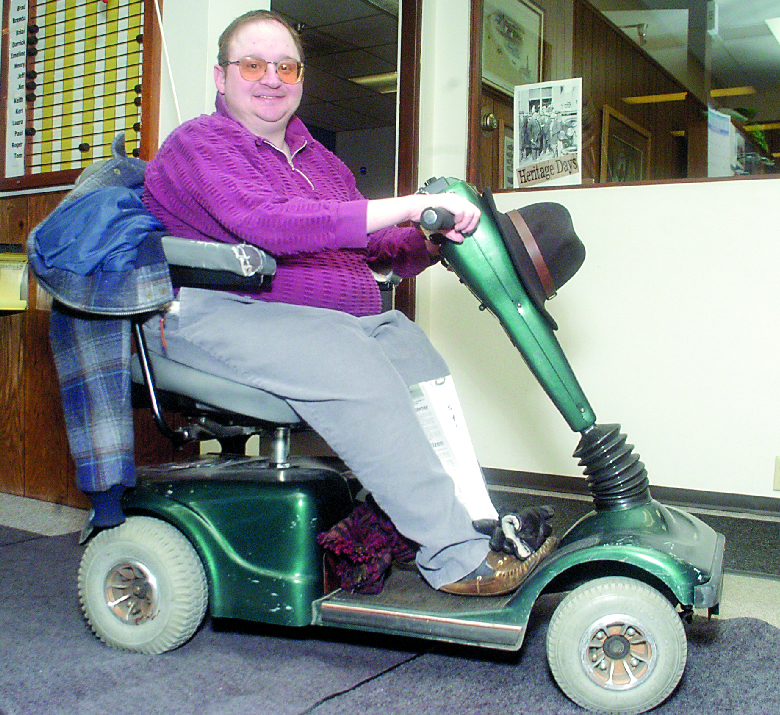 As you
can see I use
a wheelchair, and the reason is that I have Arthrogryposis; many people
don't know what this is so I searched the net and found the following
info.
Each case is different, but nevertheless here is some basic info:
As you
can see I use
a wheelchair, and the reason is that I have Arthrogryposis; many people
don't know what this is so I searched the net and found the following
info.
Each case is different, but nevertheless here is some basic info: What is arthrogryposis?
--------------------------------------------------------------------------------
Arthrogryposis (Arthrogryposis Multiplex Congenita) is a term describing the presence of a muscle disorder that causes multiple joint contractures at birth. A contracture is a limitation in the range of motion of a joint.
In some cases, few joints may be affected and the range of motion may be nearly normal. In the "classic" case of arthrogryposis, hands, wrists, elbows, shoulders, hips, feet and knees are affected. In the most severe cases, nearly every body joint may be involved, including the jaw and back. Frequently, the contractures are accompanied by muscle weakness, which further limits movement. Arthrogryposis is relatively rare, occurring in approximately one in 3,000 births.
--------------------------------------------------------------------------------
Can arthrogryposis occur again in the same family?
--------------------------------------------------------------------------------
In most cases, arthrogryposis is not a genetic condition and
does
not occur more than once in a family. In about 30% of the cases, a
genetic
cause can be identified. The risk of recurrence for these cases varies
with the type of genetic disorder.
--------------------------------------------------------------------------------
What causes arthrogryposis?
--------------------------------------------------------------------------------
Research has shown that anything that prevents normal joint
movement
before birth can result in joint contractures. The joint itself may be
normal. However, when a joint is not moved for a period of time, extra
connective tissue tends to grow around it, fixing it in position. Lack
of joint movement also means that tendons connecting to the joint are
not
stretched to their normal length; short tendons, in turn, make normal
joint
movement difficult. (This same kind of problem can develop after birth
in joints that are immobilized for long periods of time in casts.)
In general, there are four causes for limitation of joint
movement
before birth:
Muscles do not develop properly (atrophy). In most cases, the
specific
cause for muscular atrophy cannot be identified. Suspected causes
include
muscle diseases (for example, congenital muscular dystrophies),
maternal
fever during pregnancy, and viruses, which may damage cells that
transmit
nerve impulses to the muscles.
There is not sufficient room in the uterus for normal
movement.
For example, the mother may lack a normal amount of amniotic fluid, or
have an abnormally shaped uterus.
Central nervous system and spinal cord are malformed. In these
cases,
a wide range of other conditions usually accompanies
arthrogryposis.
Tendons, bones, joints or joint linings may develop
abnormally.
For example, tendons may not be connected to the proper place in a
joint.
--------------------------------------------------------------------------------
What is the treatment?
--------------------------------------------------------------------------------
For most types of arthrogryposis, physical therapy has proven
very
beneficial in improving the range of motion of affected joints. Parents
are encouraged to become active participants in a therapy program and
to
continue therapy at home on a daily basis.
Splints can be made to augment the stretching exercises to
increase
range of motion. Casting is often used to improve foot position.
However,
emphasis should be placed on achieving as much joint mobility as
possible.
Some type of removable splint (perhaps a bi-valve cast) may be used on
knees and feet so that the joints can be moved the muscled exercises
periodically.
In som cases, merely wearing a splint at night may be sufficient.
Surgery may be used to treat the congenital deformities that
frequently
occur in conjunction with arthrogryposis or should be viewed as a
supportive
measure once physical therapy has achived maximum results but more
range
of motion is needed. Surgeries are commonly performed on feet, knees,
hips,
elbows and wrists to achieve better position or greater range of
motion.
In some cases, tendon transfers have been done to improve muscle
function.
Congenital deformities of the feet, hips and spine may require surgical
correction at or about one year of age.
--------------------------------------------------------------------------------
What is the outlook?
--------------------------------------------------------------------------------
There is a wide variation in the degree to which muscles and
joints
are affected in those with arthrogryposis. In some cases,
arthrogryposis
may be accompanied by other conditions, such as central nervous system
disorders, which complicate the picture. However, in most cases, the
outlook
for those with arthrogryposis is a positive one. Unlike many other
conditions,
arthrogryposis is non-progressive; it does not worsen with age.
Furthermore,
with physical therapy and other available treatments, substantial
improvement
in function is usually possible. Most people with arthrogryposis are of
normal intelligence and are able to lead productive, independent lives
as adults.



